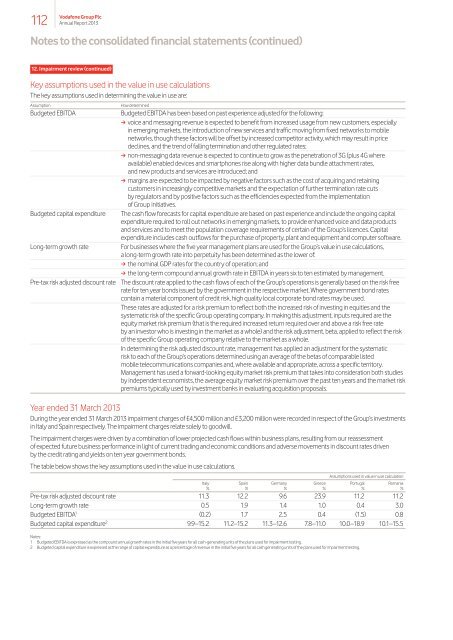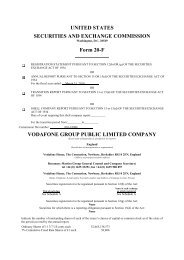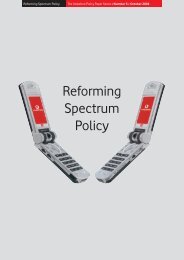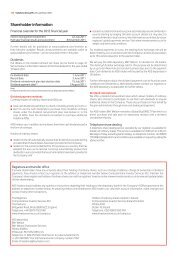The way ahead? - Vodafone
The way ahead? - Vodafone
The way ahead? - Vodafone
Create successful ePaper yourself
Turn your PDF publications into a flip-book with our unique Google optimized e-Paper software.
112<br />
<strong>Vodafone</strong> Group Plc<br />
Annual Report 2013<br />
Notes to the consolidated financial statements (continued)<br />
12. Impairment review (continued)<br />
Key assumptions used in the value in use calculations<br />
<strong>The</strong> key assumptions used in determining the value in use are:<br />
Assumption How determined<br />
Budgeted EBITDA Budgeted EBITDA has been based on past experience adjusted for the following:<br />
a voice and messaging revenue is expected to benefit from increased usage from new customers, especially<br />
in emerging markets, the introduction of new services and traffic moving from fixed networks to mobile<br />
networks, though these factors will be offset by increased competitor activity, which may result in price<br />
declines, and the trend of falling termination and other regulated rates;<br />
a non-messaging data revenue is expected to continue to grow as the penetration of 3G (plus 4G where<br />
available) enabled devices and smartphones rise along with higher data bundle attachment rates,<br />
and new products and services are introduced; and<br />
a margins are expected to be impacted by negative factors such as the cost of acquiring and retaining<br />
customers in increasingly competitive markets and the expectation of further termination rate cuts<br />
by regulators and by positive factors such as the efficiencies expected from the implementation<br />
of Group initiatives.<br />
Budgeted capital expenditure <strong>The</strong> cash flow forecasts for capital expenditure are based on past experience and include the ongoing capital<br />
expenditure required to roll out networks in emerging markets, to provide enhanced voice and data products<br />
and services and to meet the population coverage requirements of certain of the Group’s licences. Capital<br />
expenditure includes cash outflows for the purchase of property, plant and equipment and computer software.<br />
Long-term growth rate For businesses where the five year management plans are used for the Group’s value in use calculations,<br />
a long-term growth rate into perpetuity has been determined as the lower of:<br />
a the nominal GDP rates for the country of operation; and<br />
a the long‑term compound annual growth rate in EBITDA in years six to ten estimated by management.<br />
Pre‑tax risk adjusted discount rate <strong>The</strong> discount rate applied to the cash flows of each of the Group’s operations is generally based on the risk free<br />
rate for ten year bonds issued by the government in the respective market. Where government bond rates<br />
contain a material component of credit risk, high quality local corporate bond rates may be used.<br />
<strong>The</strong>se rates are adjusted for a risk premium to reflect both the increased risk of investing in equities and the<br />
systematic risk of the specific Group operating company. In making this adjustment, inputs required are the<br />
equity market risk premium (that is the required increased return required over and above a risk free rate<br />
by an investor who is investing in the market as a whole) and the risk adjustment, beta, applied to reflect the risk<br />
of the specific Group operating company relative to the market as a whole.<br />
In determining the risk adjusted discount rate, management has applied an adjustment for the systematic<br />
risk to each of the Group’s operations determined using an average of the betas of comparable listed<br />
mobile telecommunications companies and, where available and appropriate, across a specific territory.<br />
Management has used a forward‑looking equity market risk premium that takes into consideration both studies<br />
by independent economists, the average equity market risk premium over the past ten years and the market risk<br />
premiums typically used by investment banks in evaluating acquisition proposals.<br />
Year ended 31 March 2013<br />
During the year ended 31 March 2013 impairment charges of £4,500 million and £3,200 million were recorded in respect of the Group’s investments<br />
in Italy and Spain respectively. <strong>The</strong> impairment charges relate solely to goodwill.<br />
<strong>The</strong> impairment charges were driven by a combination of lower projected cash flows within business plans, resulting from our reassessment<br />
of expected future business performance in light of current trading and economic conditions and adverse movements in discount rates driven<br />
by the credit rating and yields on ten year government bonds.<br />
<strong>The</strong> table below shows the key assumptions used in the value in use calculations.<br />
Assumptions used in value in use calculation<br />
Italy Spain Germany Greece Portugal Romania<br />
% % % % % %<br />
Pre‑tax risk adjusted discount rate 11.3 12.2 9.6 23.9 11.2 11.2<br />
Long-term growth rate 0.5 1.9 1.4 1.0 0.4 3.0<br />
Budgeted EBITDA 1 (0.2) 1.7 2.5 0.4 (1.5) 0.8<br />
Budgeted capital expenditure 2 9.9–15.2 11.2–15.2 11.3–12.6 7.8–11.0 10.0–18.9 10.1–15.5<br />
Notes:<br />
1 Budgeted EBITDA is expressed as the compound annual growth rates in the initial five years for all cash‑generating units of the plans used for impairment testing.<br />
2 Budgeted capital expenditure is expressed as the range of capital expenditure as a percentage of revenue in the initial five years for all cash generating units of the plans used for impairment testing.











